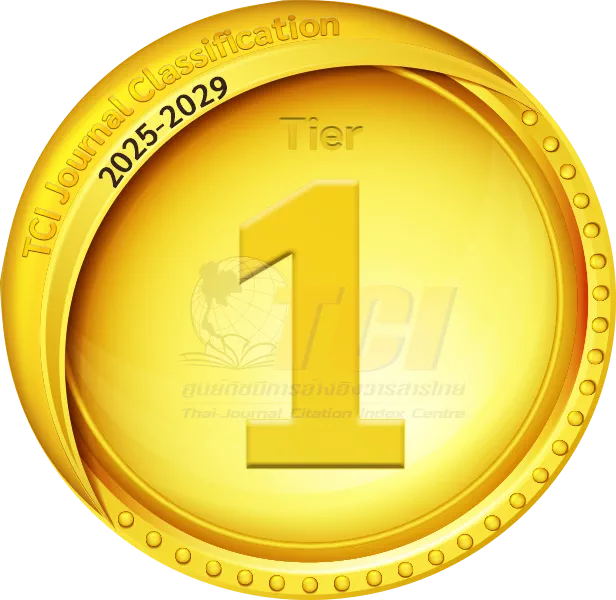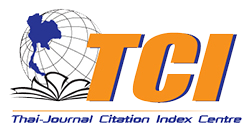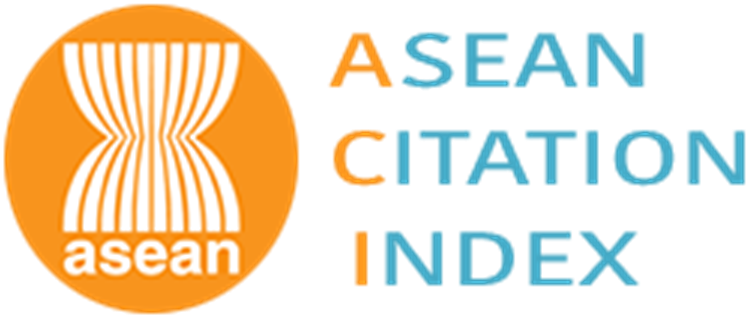ตัวแบบการโปรแกรมไม่เชิงเส้นเพื่อการวางแผนการผลิตอาหารสัตว์สำหรับเลี้ยงโคนม
Non-linear Programming Model for Dairy Cattle Feed Production Planning
Abstract
งานวิจัยนี้เป็นการประยุกต์ใช้ตัวแบบการโปรแกรมไม่เชิงเส้นเพื่อการวางแผนการผลิตอาหารสัตว์สำหรับเลี้ยงโคนมโดยมีวัตถุประสงค์ของตัวแบบเพื่อให้กำไรโดยรวมสูงที่สุด ภายใต้เงื่อนไขเกี่ยวกับปริมาณวัตถุดิบที่จัดหาได้ คุณค่าทางโภชนาการที่ต้องการ คุณค่าทางโภชนาการที่ได้จากวัตถุดิบแต่ละชนิด ราคาวัตถุดิบ ต้นทุนการผลิต ราคาจำหน่ายผลิตภัณฑ์ การสำรองสินค้าคงคลัง และความต้องการของลูกค้า โดยประมวลผลตัวแบบที่พัฒนาขึ้นด้วยโปรแกรม LINGO จากผลการวิจัยพบว่า สถานประกอบการกรณีศึกษาควรใช้วัตถุดิบ 10 ชนิด ที่มีสัดส่วนแตกต่างกันในการผสมอาหารสัตว์ โดยสัดส่วนวัตถุดิบที่ใช้มากที่สุด คือ กากถั่วเหลือง มันสำปะหลัง ใบกระถินป่น และรำข้าว รวมถึงผลลัพธ์เกี่ยวกับการตัดสินใจผลิตและจัดเก็บสินค้าคงคลังในแต่ละเดือนภายในรอบ 1 ปี ของการวางแผนการผลิต ทำให้สถานประกอบการกรณีศึกษามีกำไรโดยรวมสูงที่สุด 6,217,715.98 บาท ซึ่งสูงกว่ากำไรที่เกิดจากการดำเนินงานตามแนวทางเดิม 24.23% นอกจากนี้งานวิจัยยังมีการวิเคราะห์ความไวของตัวแบบโดยผันแปรค่าพารามิเตอร์ที่คาดว่าอาจมีความผันผวนในอนาคต และอาจส่งผลต่อกำไรโดยรวมและค่าของตัวแปรตัดสินใจ ซึ่งพบว่า เมื่อราคาจำหน่ายหรือปริมาณความต้องการผลิตภัณฑ์เพิ่มขึ้น จะส่งผลให้กำไรโดยรวมเพิ่มขึ้นอย่างชัดเจน ส่วนการเพิ่มขึ้นของราคาวัตถุดิบโดยเฉพาะมันสำปะหลังและกากถั่วเหลือง จะทำให้กำไรโดยรวมลดลงอย่างมาก แต่การเพิ่มขึ้นของราคาวัตถุดิบผสมอาหารและต้นทุนการผลิต ส่งผลกระทบเพียงเล็กน้อยต่อกำไรโดยรวม จากผลการวิจัยดังกล่าวจึงทำให้ได้ผลเฉลยที่สามารถนำไปวางแผนการผลิตอาหารโคนมได้อย่างเหมาะสม และนำไปสู่การตัดสินใจเกี่ยวกับสัดส่วนการผสมวัตถุดิบ ปริมาณการผลิต และปริมาณสินค้าคงคลังที่สอดคล้องกับความต้องการของลูกค้าในแต่ละช่วงเวลา
This research applied a nonlinear programming model to plan feed production for dairy cattle. The model objective is to maximize total profit subject to the constraints of the amount of available raw materials, required nutritional value, nutritional value of each type of raw material, raw material prices, production costs, product selling prices, safety stock, and customer demand. The developed model was processed using the LINGO program. The results show that the case study should use 10 raw materials in various proportions to mix dairy cattle feed. The most used raw materials are soybean meal, cassava, powdered mimosa leaves, and rice bran. The results also include information on production and inventory decisions for each month of the annual production planning. In addition, the model sensitivity was analyzed by varying the parameters that are expected to affect total profit and decision variables. The results showed that the case study establishment had the highest total profit of 6,217,715.98 baht, which was 24.23% higher than the profit from the original operation. In addition, the research also provides sensitivity analysis of the model by varying the parameters that are expected to fluctuate in the future and may affect the overall profit and the values of the decision variables. It was found that when the selling price or demand increased, the total profit would increase significantly. As for the increase in the price of raw materials, especially cassava and soybean meal, the total profit would decrease significantly. However, the increase in the price of food ingredients and production costs had only a slight impact on the total profit. Therefore, the research results provide solutions for production planning of dairy cattle feed appropriately, leading to decisions about raw material mixing ratios, production volume, and inventory volume that are consistent with the customers demand in each period.
Keywords
[1] C. Kantanamalakul. Animal Feed Industry in Thailand. [Online] (in Thai). Available: https:// agri.stou.ac.th/page/home.aspx
[2] Bureau of Animal Nutrition Development. Livestock recommends ways to reduce livestock production costs and animal feed costs for farmers. [Online] (in Thai). Available: https://nutrition.dld.go.th/nutrition/index.php
[3] Division of Livestock Extension and Development, A manual for promoting the raising of beef cattle, buffalo, and watershed cattle. Bangkok: The Agricultural Co-operative Federation of Thailand, LTD., 2021 (in Thai).
[4] Department of Livestock Development, A manual of dairy farming. Bangkok: The Agricultural Co-operative Federation of Thailand, LTD., 2016 (in Thai).
[5] Thai Feed Mill Association (TFMA). Animal feed demand. [Online] (in Thai). Available: https:// www.thaifeedmill.org/
[6] S. A. Kumar and N. Suresh, Production andOperations Management. New Delhi: New Age International, 2008.
[7] S. Gupta and M. Starr, Production and Operations Management Systems. Florida: CRC Press, 2014.
[8] B. Render, R. Stair, and M. E. Hanna, Quantitative Analysis for Management. New Jersey: Prentice Hall, 2012.
[9] I. Soares, M. J. Alves, and C. H. Antunes, “A deterministic bounding algorithm vs. a hybrid meta-heuristic to deal with a bilevel mixedinteger nonlinear optimization model for dynamic electricity pricing,” Computers & Operations Research, vol. 155, pp. 106–195, 2023.
[10] N. Bootwisas, P. Marupanthon, K. Marupanthorn, U. Intarasat, and W. Ketpanyapong. “Moringa leaf powder production planning using mixedinteger linear programming,” Journal of Management Science, Suratthani Rajabhat University, vol. 9, no. 2, pp. 269–292, 2022 (in Thai).
[11] W. Winitchaiy and R. Homchalee, “Application of linear programming model for managing jasmine rice supply chain network in Thung Kula Ronghai area of Thailand,” KMUTT Research & Development Journal, vol. 44, no. 1, pp. 731–754, 2021 (in Thai).
[12] J. Sukmok, “Finding egg-laying chicken feed recipe for pre-starters,” Rangsit University Journal of Engineering and Technology. vol. 20, no. 2, pp. 25–36, 2017 (in Thai).
[13] S. Midevan and P. Sudasna-Na-Ayudthya, “Efficiency improvement in warehouse and cost reduction for pet’s food factory,” Journal of Industrial Technology Ubon Ratchathani Rajabhat University, vol. 3, no. 6, pp. 1–12, 2013 (in Thai).
[14] S. Irawan, S. T. Risyahadi, and H. Wijaya, “The supply chain planning optimization model for the cattle feed industry with a linear programming approach,” Proceedings, vol. 83, no. 1, pp. 1–15, 2022.
[15] R. S. Porchelvi, J. Irine, and R. Regupathi, “Linear programming method for solving optimized nutrients feed formulation in GIFT Tilapia,” IOSR Journal of Humanities and Social Science (IOSR-JHSS), vol. 23, no. 10, pp. 28–33, 2018.
[16] A. Csikai, “Opportunities of integrating supply chain quality management and product development with formulation systems in compound feed manufacturing,” Quality Assurance and Safety of Crops & Foods, vol. 3, no. 2, pp. 82–88, 2011.
[17] Information and Communication Technology Center, Livestock Numbers in Thailand 2024. Bangkok: Department of Livestock Development, 2024 (in Thai).
[18] Maha Sarakham Provincial Public Relations Office. Government agency administration policy, Ministry of Agriculture and Cooperatives. [Online] (in Thai). Available: https://mahasarakham. prd.go.th/th/content/categoryindex/id/9
[19] LINGO: The Modeling Language and Optimizer, LINDO Systems, Inc., Chicago, Illinois, 2018
[20] M-Focus. What's LINDO software? [Online] (in Thai). Available: https://www.m-focus.co.th/ Lindo.html
[21] A. E. Çelikdin, “Optimizing seasonal grain intakes with non-linear programming:An application in the feed industry,” An International Journal of Optimization and Control: Theories & Applications, vol. 12, no. 2, pp. 79–89, 2022.
[22] P. Saxena, “Comparison of linear and nonlinear programming techniques for animal diet,” Applied Mathematics, vol. 1, no. 2, pp. 106–108, 2011.
[23] P. Saxena and N. Khanna, “Modeling and algorithm development for cattle feed mix formulation,” International Journal of Computational Intelligence Research, vol. 13, no. 1, pp. 141–159, 2017.
[24] G. Notte, H. Cancela, M. Pedemonte, P. Chilibroste, W. Rossing, and J. C. J. Groot, “A multi-objective optimization model for dairy feeding management,” Agricultural Systems, vol. 183, pp. 102854, 2020.
DOI: 10.14416/j.kmutnb.2025.03.001
ISSN: 2985-2145





